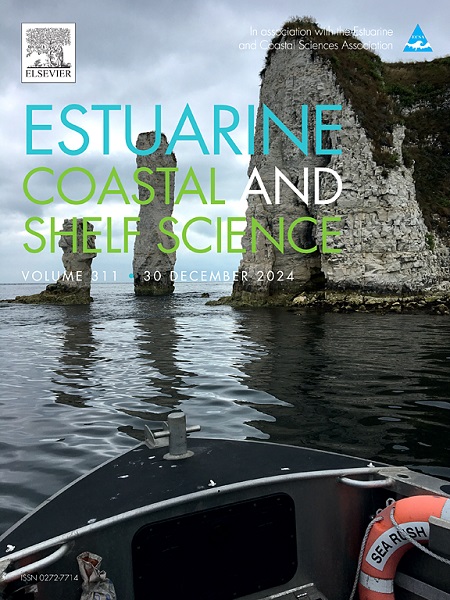Seafloor temperature variability in the Zhoushan Archipelago: Patterns and mechanisms
IF 2.6
3区 地球科学
Q1 MARINE & FRESHWATER BIOLOGY
引用次数: 0
Abstract
Sea water temperature is one of the most critical environmental parameters for characterizing and regulating marine biogeochemical processes. Due to limited observational data, past researches have primarily focused on water temperature in the upper ocean, with relatively little attention given to the spatiotemporal evolution and modulation mechanisms of seafloor temperature (SFT). Utilizing continuous, high-frequency in situ SFT data collected by submarine cable observation systems at four stations (Dongji 1, Dongji 2, Dajishan, and Zhairuoshan) in the Zhoushan Archipelago area (ZA) from October 2020 to December 2021, we examined the patterns and regulatory mechanisms of SFT variability within this region. Results show that at the Dongji 1, Dongji 2, and Dajishan stations, the diurnal standard deviation (STD) of SFT exhibits a remarkable seasonal pattern, being higher in winter and summer, and lower in spring and autumn, at the same time, SFT displays significant semi-diurnal and diurnal periodic signals during winter and summer, which nearly disappear in spring and autumn; at the Zhairuoshan station, periodic variations in SFT are minimal throughout the year. Further analyses of multi-source sea temperature data and results from Lagrangian particle tracking point out that the diurnal STD of SFT at Dongji 1, Dongji 2, and Dajishan stations is mainly dominated by the distinct sea temperature background and water exchange between the ZA and adjacent water: due to strong tidal mixing and shallow topography, the ZA, Hangzhou Bay and along with the southern regions of the Yangtze River Estuary exhibits weak stratification throughout the year. In winter, under the control of tidal currents and the southward Zhejiang-Fujian Coastal Current (ZFCC), daily water exchange in ZA primarily with the colder waters originating from Hangzhou Bay and the southern Yangtze River Estuary. While during summer, the ZA is occupied by cold upwelling, and dominated by tidal currents and the northward ZFCC, thus ZA mainly exchange with warmer waters from Hangzhou Bay and the southeastern side of the archipelago within a day. Therefore, this seasonal variation results in larger diurnal STDs of SFT in winter and summer. In contrast, during the monsoon transition period of spring and autumn, the horizontal and vertical distribution of sea temperature across the ZA and its adjacent water is generally uniform, leading to smaller diurnal STD of SFT. The relatively enclosed hydrological environment of Zhairuoshan station leads to limited daily water exchange, resulting in consistently weak diurnal STD of SFT year-round.
舟山群岛海底温度变化:模式和机制
海水温度是表征和调节海洋生物地球化学过程的重要环境参数之一。由于观测资料有限,以往的研究主要集中在上层海洋的水温,对海底温度的时空演变及其调节机制的研究相对较少。利用2020年10月至2021年12月舟山群岛4个海缆观测站(东集1号、东集2号、大集山和寨若山)连续采集的高频SFT原位数据,研究了该地区SFT的变化模式和调控机制。结果表明:东集1号站、东集2号站和大集山站SFT的日标准差(STD)表现出明显的季节特征,冬、夏季较高,春、秋季较低;同时,SFT在冬、夏季表现出明显的半日和日周期信号,春、秋季基本消失;在寨若山站,全年的SFT周期变化极小。进一步多源海温资料分析和拉格朗日粒子跟踪结果表明,东集1、东集2和大集山站的SFT日STD主要受明显的海温背景和ZA与邻近水域的水交换支配,ZA、杭州湾及长江口南部地区由于强烈的潮汐混合和浅层地形,全年呈现弱分层。冬季,在潮流和南向的浙闽海流的控制下,ZA的日水交换以杭州湾和长江口南部的较冷水域为主。夏季ZA以冷上升流为主,以潮流和向北的ZFCC为主,因此ZA主要在一天内与杭州湾和群岛东南侧的暖水交换。因此,这种季节变化导致冬季和夏季SFT的日std较大。而在春季和秋季季风过渡期,整个ZA及其邻近海域的海温水平和垂直分布基本均匀,导致SFT的日STD较小。寨若山站相对封闭的水文环境导致日换水量有限,导致SFT日STD常年持续较弱。
本文章由计算机程序翻译,如有差异,请以英文原文为准。
求助全文
约1分钟内获得全文
求助全文
来源期刊
CiteScore
5.60
自引率
7.10%
发文量
374
审稿时长
9 months
期刊介绍:
Estuarine, Coastal and Shelf Science is an international multidisciplinary journal devoted to the analysis of saline water phenomena ranging from the outer edge of the continental shelf to the upper limits of the tidal zone. The journal provides a unique forum, unifying the multidisciplinary approaches to the study of the oceanography of estuaries, coastal zones, and continental shelf seas. It features original research papers, review papers and short communications treating such disciplines as zoology, botany, geology, sedimentology, physical oceanography.

 求助内容:
求助内容: 应助结果提醒方式:
应助结果提醒方式:


